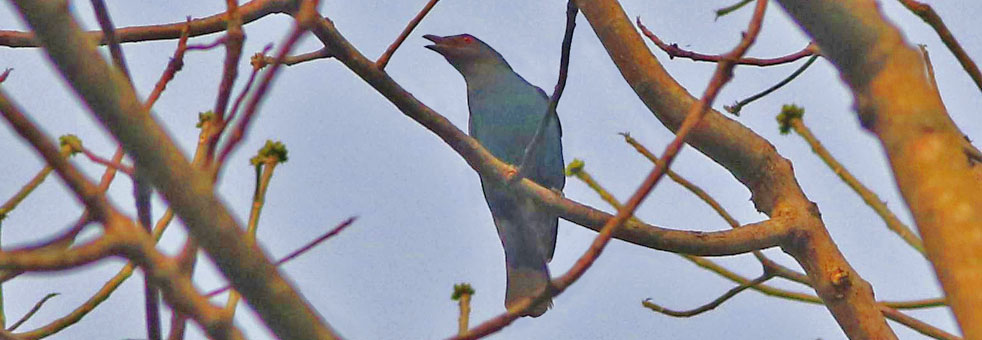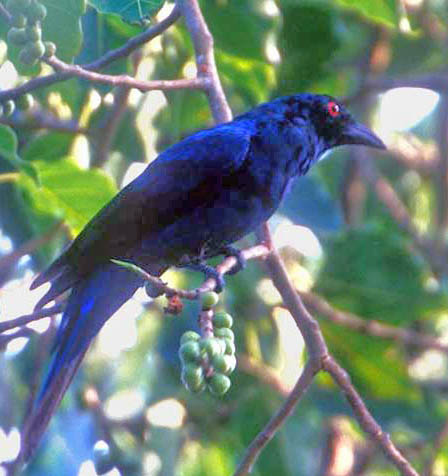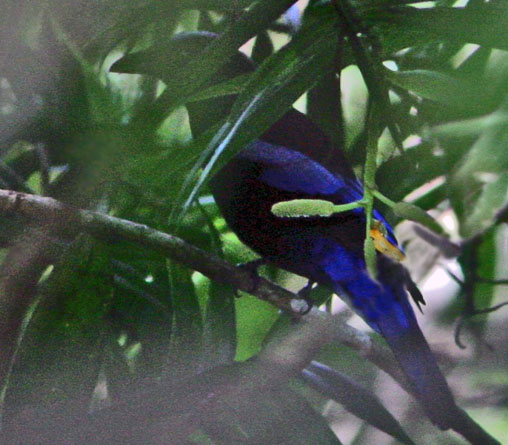
a web page by Don Roberson |
FAIRY-BLUEBIRDS Irenidae |
|
The widespread bird ranging from eastern India through southeast Asia to Java and Palawan in the Philippines is Asian Fairy-Bluebird (male left in a nice shot from the Andaman Islands by Ron Saldino). The species is sexually dimorphic with males having a brilliant blue crown, mantle, rump, and tail that contrasts with a jet-black head, breast, and wings. Females are duller and more greenish-blue (photo below from Assam, India). The feathers are loosely attached (a trait shared with smaller leafbirds in the canopy of lowlands rainforests. Fairy-bluebirds eat mostly fruit, especially figs, and all the photos on this page are of birds in fruiting trees. A technical description notes they have strong and slightly decurved beak and the maxillary tomium has a subterminal notch, they have operculate nostrils, and possess short thick tarsi and short toes (Wells 2005). |
 |
The only other member of the family is Philippine Fairy-Bluebird (male right). Philippine Fairy-bluebird is endemic to the major Philippine islands —except Palawan, where race tweeddalei of Asian Fairy-bluebird occurs, replacing the Philippine endemic. It is also sexually dimorphic, with females somewhat duller than males. There are four subspecies, on which is ellae of Samar, Leyte, and Bohol (the male at right was on Bohol). It is similar to male Asian Fairy-bluebird in having having black underparts and black, contrasting with dark royal blue scapulars and rump. The other Philippine races have black face and throat, but then the black underparts and mantle are replaced with deep indigo-blue. This male is sitting in the shadows quietly, and could be easily overlooked. The same bird in present (below) — but in a view that shows more of the tree — and is most noted because my flash lit up the eye. Fairy-bluebirds are essentially resident in the lowland rainforest but in some areas are subject to seasonal movements as might be expected from a fig-eating specialist; they will glean insects from time to time. The usually occur in pairs or small flocks. |
 |
The breeding biology of the Philippine species is not well known, but Asian Fairy-bluebirds have rough platform nests of long twigs topped by a layer of green moss and lining of rootlets placed in the fork of a dense tree. Only the female builds the nest but both sexes feed the young (Wells 2005). My experiences are not extensive. In the Panbari Forest near Kaziranga NP, Assam, India, they sat high in the canopy of fruiting trees giving mellow liquid notes but never stayed in any spot for very long. Most of my efforts at photography yielded only a silhouette of a chunky short-tailed individual up in that canopy. Despite this lack of experience I do see similarities in their shape, size, diet and behaviors with the pihas and fruiteaters in the Cotinga family of South American tropics. Fairy-bluebirds were traditionally considered related to bulbuls (Pycnonotidae) but having some characters of drongos (Dicruridae) or cuckoo-shrikes (Campepahagidae; Austin & Singer 1961). Initial DNA hybridization studies suggested closer relationships to bushshrikes and vangas within Sibley & Alquist's (1990) greatly expanded corvoid assemblage. In this century, molecular evidence suggests that they are most closely related to leafbirds (Chloropseidae; Beresford et al. 2005, Treplin et al. 2008, Fuchs et al. 2012, Aggerbeck et al. 2014). Together with leafbirds, fairy-bluebirds may be next closest to sunbirds (Nectariniidae) plus flowerpeckers (Dicaeidae; Johansson et al. 2008). Current taxonomies place fairy-bluebirds next to leafbirds and near the sunbirds in the "passeroid" assemblage. |
Photos: Ron Saldino photographed the male Asian Fairy-bluebird Irena puella on Mt. Harriet, South Andaman Island, India, on 9 Mar 2001. The female Asian Fairy-bluebird was at the Bagori tea plantation, near Kaziranga NP, Assam, India, on 14 Mar 2019. The two shots of a male Philippine Fairy-bluebird Irena cyanogaster ellae were at Rajah Sikatuna NP, Bohol, Philippines, on 20 Dec 2005. All photos © Don Roberson; all rights reserved. Bibliographic note: There is no "family book" per se, but a good introduction to this family, with photos, is in Wells (2005). Literature cited:
|
 The Fairy-bluebirds are a small family of just two species of arboreal passerines found throughout tropical Asia. Both species are chunky, moderately large, heavy-billed birds with bright-red eyes in the genus Irena. Despite having bright blue-and-black coloration, fairy-bluebirds can be difficult to see in the canopy, where they often sit quietly and can "disappear" in the shadows.
The Fairy-bluebirds are a small family of just two species of arboreal passerines found throughout tropical Asia. Both species are chunky, moderately large, heavy-billed birds with bright-red eyes in the genus Irena. Despite having bright blue-and-black coloration, fairy-bluebirds can be difficult to see in the canopy, where they often sit quietly and can "disappear" in the shadows. 